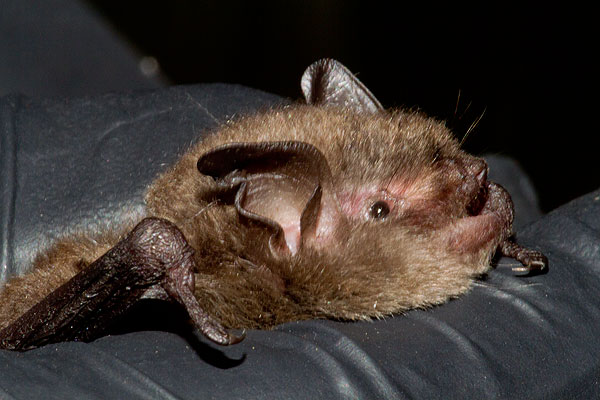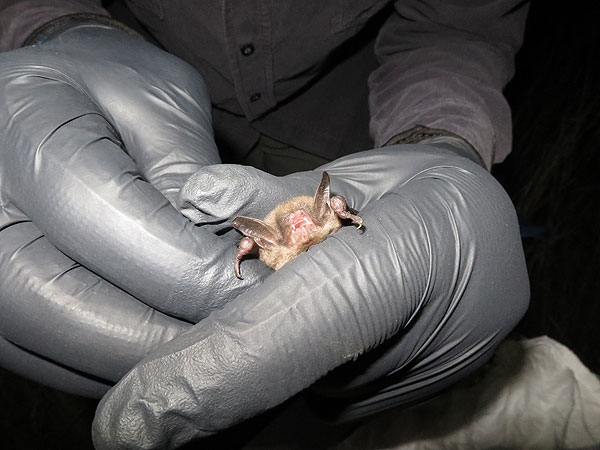After field work in the north and central parts of Illinois, we recently spent two nights mist netting at Paul Wightman Subterranean Nature Preserve, in southwestern Illinois (Monroe County). A patchwork of forest fragments, restored prairie, and ponds, this property is also the site of the IBCP’s first capture of the endangered Indiana bat, Myotis sodalis.

The name myotis is Latin for mouse-like, and refers to the ears of these bats.
Covered in dark-brown fur and with “mouse-like” ears, the Indiana bat is similar in appearance to several closely related species in Illinois, including the little brown bat, Myotis lucifugus. Found only in North America, the Indiana bat’s range stretches from North Carolina to New York, and west to Arkansas, Missouri, and Iowa.
The Indiana bat was listed as an endangered species in 1967, primarily because of disturbance to hibernacula, the caves where large groups of Indiana bats hibernate. The name sodalis is the Latin word for companion, referring to the Indiana bat’s roosting behavior. In the winter, these bats hibernate in groups as large as 50,000, and during the summer females roost in groups of up to 100. Unfortunately, their tendency to aggregate in large clusters means that if a hibernaculum is disturbed by human activity, there is the potential for large numbers of bats to be affected. Hibernating in large groups may mean that Indiana bats are more likely to readily transmit to White-Nose Syndrome (WNS), a fungal disease that has killed millions of bats in the United States, to uninfected individuals in these clusters. First discovered in 2006 in New York, WNS has been spreading westward. As this fungus grows on hibernating bats, they prematurely use up the precious energy stores they need to survive the winter. Unfortunately, WNS causes mortality for many hibernating bats before spring arrives.

Like many North American bat species, the Indiana bat is very small. The juvenile we captured weighed only 7.3 grams- only a quarter of an ounce.
However, there is potential for recovery by this species. The Indiana bat we captured in southern Illinois was a juvenile, meaning that there is a breeding population nearby. This bat will spend the rest of fall feeding on flying insects to build up the fat stores she needs for the winter. Feeding on insects flying near ponds, wetlands and forest edges, this bat may eat up to half her weight in insects each night. While there are individual and seasonal variations in diets, available data indicates that Indiana bats tend to feed on beetles, caddisflies, mosquitos, moths, and wasps.
White-Nose Syndrome is a serious issue that may lead to the extinction or sever population reduction for several bat species in North America. The U.S. Fish and Wildlife Service is providing significant funding to help addressing this issue, but as yet there are no cures or effective treatments. But it’s important to remember that breeding populations mean that there are glimmers of hope for the future of the Indiana bat.

